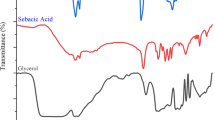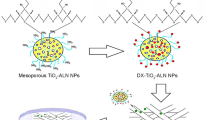Abstract
A novel biocompatible copolymer membrane was synthesized and characterized for use in guided bone regeneration using polymeric soybean oil-g-polystyrene (PSO-g-PS) graft copolymer which was successfully obtained by free radical polymerization of styrene initiated by PSO peroxide as a macroinitiator at 80 °C. Osteoblastic cellular activities of MC3T3-E1 cells on PSO-g-PS membranes with different soybean oil composition (PSO-g-PS1, PSO-g-PS2, and PSO-g-PS3) were evaluated. Nuclear magnetic resonance (1H NMR) spectra showed that PSO inclusion (mol%) was found to be 27, 69, and 51 % for PSO-g-PS1, PSO-g-PS2, and PSO-g-PS3 membranes, respectively. Superior biocompatibility of the PSO-g-PS membranes was determined compared to polystyrene tissue culture plates (TCPS) as positive control. Cell proliferation was enhanced on PSO-g-PS2 and PSO-g-PS3 membranes compared to PSO-g-PS1 membranes (p < 0.001), and a statistically significant higher ALP value of MC3T3-E1 cells on PSO-g-PS2 membranes (p < 0.05) suggested that proliferation and differentiation of preosteoblastic on PSO-g-PS membranes were enhanced with regard to soybean oil content within the membranes. Thus, the present study suggests that PSO-g-PS2 membranes, which showed a favorable biological environment for the preosteoblastic cells, can be well suited for bone tissue engineering applications.






Similar content being viewed by others
References
Jung RE, Zwahlen R, Weber FE, Molenberg A, Van Lenthe GH, Hammerle CH (2006) Evaluation of an in situ formed synthetic hydrogel as a biodegradable membrane for guided bone regeneration. Clin Oral Implants Res 17:426–433
Hämmerle CH, Jung RE (2003) Bone augmentation by means of barrier membranes. Periodontology 2000(33):36–53
Hallman M, Sennerby L, Lundgren S (2002) A clinical and histologic evaluation of implant integration in the posterior maxilla after sinus floor augmentation with autogenous bone, bovine hydroxyapatite, or a 20:80 mixture. Int J Oral Maxillofac Implants 17(5):635–643
De Macedo NL, De Macedo LG, Monteiro Ado S (2008) Calcium sulfate and PTFE nonporous barrier for regeneration of experimental bone defects. Med Oral Patol Oral Cir Bucal 13:E375–E379
Fujihara K, Kotaki M, Ramakrishna S (2005) Guided bone regeneration membrane made of polycaprolactone/calcium carbonate composite nano-fibers. Biomaterials 26:4139–4147
Gielkens PFM, Schortinghuis J, de Jong JR, Raghoebar GM, Stegenga B, Bos RRM (2008) Vivosorb (R), Bio-gide (R), and Gore-tex (R) as barrier membranes in rat mandibular defects: an evaluation by microradiography and micro-CT. Clin Oral Implants Res 19:516–521
van Leeuwen AC, Huddleston Slater JJ, Gielkens PF, de Jong JR, Grijpma DW, Bos RR (2012) Guided bone regeneration in rat mandibular defects using resorbable poly(trimethylene carbonate) barrier membranes. Acta Biomater 8:1422–1429
Monteiro ASF, Macedo LGS, Macedo NL, Balducci I (2010) Polyurethane and PTFE membranes for guided bone regeneration: histopathological and ultrastructural evaluation. Med Oral Patol Oral Cir Bucal 1(15):e401–e406
Piattelli A, Scarano A, Paolantonio M (1996) Bone formation inside the material interstices of e-PTFE membranes: a light microscopical and histochemical study in man. Biomaterials 17:1725–1731
Piattelli A, Scarano A, Russo P, Matarasso S (1996) Evaluation of guided bone regeneration in rabbit tibia using bioresorbable and non-bioresorbable membranes. Biomaterials 17:791–796
Stavropoulos F, Dahlin C, Ruskin JD, Johansson C (2004) A comparative study of barrier membranes as graft protectors in the treatment of localized bone defects. An experimental study in a canine model. Clin Oral Implan Res 15:435–442
Machtei EE (2001) The effect of membrane exposure on the outcome of regenerative procedures in humans: a meta-analysis. J Periodontol 72:512–516
Huang J, He H, Sheng L, Gu G (2002) Comparison of calcium alginate film with collagen membrane for guided bone regeneration in mandibular defects in rabbits. J Oral Maxillofac Surg 60:1449–1454
Kikuchi M, Koyama Y, Yamada T, Imamura Y, Okada T, Shirahama N, Akita K, Takakuda K, Tanaka J (2004) Development of guided bone regeneration membrane composed of β-tricalcium phosphate and poly (l-lactide-co-glycolide-co-e-caprolactone) composites. Biomaterials 25:5979–5986
Can E, Wool RP, Küsefoğlu S (2006) Soybean and castor oil based monomers, synthesis and copolymerization with styrene. J Appl Polym Sci 102:2433–2477
Ilter S, Hazer B, Borcakli M, Atici O (2001) Graft copolymerization of methyl methacrylate onto bacterial polyester containing unsaturated side chains. Macromol Chem Phys 202:2281–2286
Biermann U, Bornscheuer U, Meier MAR, Metzger JO, Schafer HJ (2011) Oils and fats as renewable raw materials in chemistry. Angew Chem Int Ed 50:2–20
Guner FS, Usta S, Erciyes AT, Yagci Y (2000) Styrenation of triglyceride oils by macromonomer technique. J Coat Technol 72:107–110
Ligadas G, Ronda JC, Galia M, Cadiz V (2010) Plant oils as platform chemicals for polyurethane synthesis: current state-of-the-art. Biomacromolecules 11:2825–2835
Tan SG, Chow WS (2011) Thermal properties, curing characteristics and water absorption of soybean oil-based thermoset. Express Polym Lett 5:480–492
Soucek MD, Khattab T, Wu J (2012) Review of autoxidation and driers. Prog Org Coat 73:435–454
Acar M, Çoban S, Hazer B (2013) Novel water soluble soya oil polymer from oxidized soya oil polymer and diethanolamine. J Macromol Sci Part A: Pure Appl Chem 50:287–296
Narine SS, Kong X, Bouzidi L, Sporns P (2007) Physical properties of polyurethanes produced from polyols from seed oils: II foams. J Amer Oil Chem Soc 84:65–72
Xia Y, Larock RC (2010) Vegetable oil-based polymeric materials: synthesis, properties, and applications. Green Chem 12:1893–1909
Cakmakli B, Hazer B, Tekin IO, Kizgut S, Koksal M, Menceloglu Y (2004) Synthesis and characterization of polymeric linseed oil grafted methyl methacrylate or styrene. Macromol Biosci 4:649–655
Keleş E, Hazer B (2008) Autooxidized polyunsaturated oils/oily acids: post-it applications and reactions with Fe(III) and adhesion properties. Macromol Symp 269:154–160
Çakmakli B, Hazer B, Tekin İÖ, Cömert FB (2005) Synthesis and characterization of polymeric soybean oil-g-methyl methacrylate (and n-butyl methacrylate) graft copolymers: biocompatibility and bacterial adhesion. Biomacromolecules 6:1750–1758
Vinu R, Marimuthu A, Giridhar M (2010) Enzymatic degradation of poly(soybean oil-g-methyl methacrylate). J Polym Eng 30:57–76
Allı A, Hazer B (2008) Poly(N-isopropyl acrylamide) thermoresponsive cross-linked conjugates containing polymeric soybean oil and/or polypropylene glycol. Eur Poly J 44:1701–1713
Hazer DB, Kilicay E, Hazer B (2012) Poly (3-hydroxyalkanoate)s: diversification and biomedical applications. A state of the art review. Mat Sci Eng C 32:637–647
Hazer DB, Hazer B, Kaymaz F (2009) Synthesis of microbial elastomers based on soybean oily acids. Biocompatibility studies. Biomed Mater 4:035011
Liu Z, Xu Y, Cao L, Bao C, Sun H, Wang L, Daib K, Zhu L (2012) Phosphoester cross-linked vegetable oil to construct a biodegradable and biocompatible elastomer. Soft Matter 8:5888–5895
Wang Z, Zhang X, Wang R, Kang H, Qiao B, Ma J, Zhang L, Wang H (2012) Synthesis and characterization of novel soybean-oil-based elastomers with favorable processability and tunable properties. Macromolecules 45(22):9010–9019
Miao S, Sun L, Wang P, Liu R, Su Z, Zhang S (2012) Soybean oil-based polyurethane networks as candidate biomaterials: synthesis and biocompatibility. Eur J Lipid Sci and Technol 114:1165–1174
Wu B, Lenz RW, Hazer B (1999) Polymerization of methyl methacrylate and its copolymerization with caprolactone catalyzed by isobutyl alumoxane catalyst. Macromolecules 32:6856–6859
Akman AC, Tığlı RS, Gümüşderelioğlu M, Nohutçu RM (2010) Bone morphogenetic protein-6-loaded chitosan scaffolds enhance the osteoblastic characteristics of MC3T3-E1 cells. Artif Organs 34(1):65–74
Gümüşderelioğlu M, Karakeçili A, Demirtaş TT (2011) Osteogenic activities of MC3T3-E1 cells on heparin-immobilized poly(caprolactone) membranes. J Bioact Compat Pol 26(3):257–267
Akman AC, Tığlı RS, Gümüşderelioğlu M, Nohutçu RM (2010) bFGF-loaded HA–chitosan: a promising scaffold for periodontal tissue engineering. J Biomed Mater Res A 92A(3):953–962
Hazer B (1995) Grafting on polybutadiene with macro or macromonomer initiators containing poly(ethylene glycol) units. Macromol Chem Phys 196:1945–1952
Ajiro H, Akashi M (2010) Cell proliferation on stereoregular isotactic-poly(propylene oxide) as a bulk substrate. Biomacromolecules 11:2840–2844
Lukyanova L, Franceschi-Messant S, Vicendo P, Pereza E, Rico-Lattes I, Weinkamer R (2010) Preparation and evaluation of microporous organogel scaffolds for cell viability and proliferation. Colloid Surf B 79:105–112
Li J, Yun H, Gong Y, Zhao N, Zhang X (2006) Investigation of MC3T3-E1 cell behavior on the surface of GRGDS-coupled chitosan. Biomacromolecules 7:1112–1123
Tığlı RS, Kazaroğlu NM, Maviş B, Gümüşderelioğlu M (2011) Cellular behavior on epidermal growth factor (EGF)-immobilized PCL/gelatin nanofibrous scaffolds. J Biomater Sci Polymer Ed 22:207–223
Tığlı RS, Gümüşderelioğlu M (2009) Chondrogenesis on BMP-6 loaded chitosan scaffolds in stationary and dynamic cultures. Biotechnol Bioeng 104(3):601–610
Sudo H, Kodama HA, Amagai Y, Yamamoto S, Kasai S (1983) In vitro differentiation and calcification in a new clonal osteogenic cell line derived from newborn mouse calvaria. J Cell Biol 96:191–198
Acknowledgments
The Authors thank to TÜBİTAK (Grant No. 211T016) and Bülent Ecevit University (Grant# 2011-10-3-02) for financial support.
Author information
Authors and Affiliations
Corresponding authors
Rights and permissions
About this article
Cite this article
Tığlı Aydın, R.S., Hazer, B., Acar, M. et al. Osteogenic activities of polymeric soybean oil-g-polystyrene membranes. Polym. Bull. 70, 2065–2082 (2013). https://doi.org/10.1007/s00289-013-0976-2
Received:
Revised:
Accepted:
Published:
Issue Date:
DOI: https://doi.org/10.1007/s00289-013-0976-2




